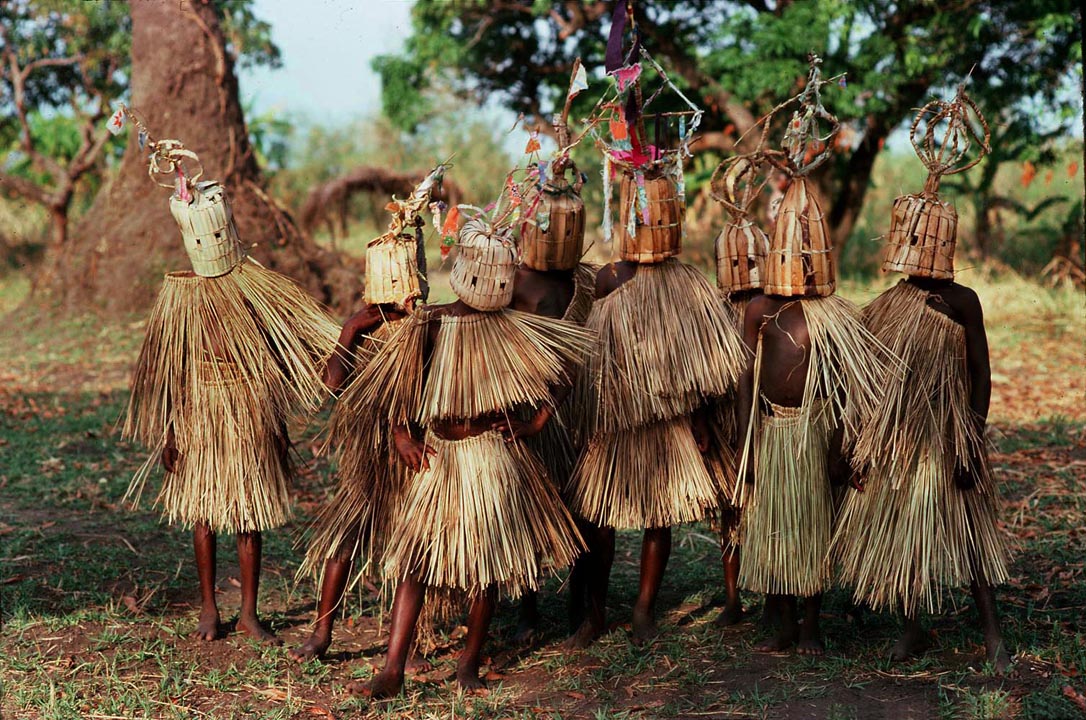

通過儀礼
rite of passage


ファ ン=ヘネップ(Arnold Van Gennep)による通過儀礼(rite of passage)には、その過程において2つの相と3つの段階がある。2つの相とは、日常と非日常。3つの段階とは、(i)分離、(ii)移行・境界、そ して(iii)統合である。
以下は、英語版のウィキペディアからの引用である
”A rite of passage is a ceremony or ritual of the passage which occurs when an individual leaves one group to enter another. It involves a significant change of status in society. In cultural anthropology the term is the Anglicisation of rite de passage, a French term innovated by the ethnographer Arnold van Gennep in his work Les rites de passage, "The Rites of Passage". The term is now fully adopted into anthropology as well as into the literature and popular cultures of many modern languages.” - rite of passage.
通過儀礼とは、ある個人がある集団から別の集団に入 る際に行われる「(象徴的に観察できる)通過現象を伴う儀礼」のこと である。これは、社会における地位の著しい変化を伴うものである。文化人類学では、民族学者のアーノルド・ファン=ヘネップが『通過儀礼』(Les rites de passage)という著書の中で提唱したフラン ス語である「通過儀礼」を英語化した言葉である。この言葉は現在、人類学だけでなく、多くの現代言語の文学や大衆文化にもほとんどの多くの場面で採用され ている用語である」。
写真:9–10-year-old boys of the Yao tribe in Malawi participating in circumcision and initiation rites. Steve Evans from Citizen of the World - Malawi.
| In English, Van
Gennep's first sentence of his first chapter begins: "Each larger society contains within it several distinctly separate groupings. ... In addition, all these groups break down into still smaller societies in subgroups." The population of a society belongs to multiple groups, some more important to the individual than others. Van Gennep uses the metaphor, "as a kind of house divided into rooms and corridors." A passage occurs when an individual leaves one group to enter another; in the metaphor, he changes rooms. Van Gennep further distinguishes
between "the secular" and "the sacred
sphere." Theorizing that civilizations are arranged on a scale,
implying that the lower levels represent "the simplest level of
development," he hypothesizes that "social groups in such a society
likewise have magico-religious foundations." Many groups in modern
industrial society practice customs that can be traced to an earlier
sacred phase. Passage between these groups requires a ceremony, or
ritual hence rite of passage. The rest of Van Gennep's book presents a description of rites of passage and an organization into types, although in the end he despairs of ever capturing them all:[4] "It is but a rough sketch of an immense picture ...." He is able to find some universals, mainly two: "the sexual separation between men and women, and the magico-religious separation between the profane and the sacred." (Earlier the translators used secular for profane.) He refuses credit for being the first to recognize type of rites. In the work he concentrates on groups and rites individuals might normally encounter progressively: pregnancy, childbirth, initiation, betrothal, marriage, funerals and the like. He mentions some others, such as the territorial passage, a crossing of borders into a culturally different region, such as one where a different religion prevails. |
Van
Gennepの第1章の最初の文章(英訳)はこう始まる。 「それぞれの大きな社会は、その中にいくつかの明確に分離したグループを含んでい る。... さらに、これらのグループはすべて、サブグループのさらに小さな社会に分解される。" 社会の人口は複数のグループに属しており、その中には個人にとって他よりも重要なものもある。Van Gennepは、"部屋と廊下に分かれた一種の家のようなもの "という比喩を使っています。通過とは、個人があるグループから別のグループに入ることであり、この比喩では部屋を変えることを意味する。 さらにVan Gennepは、「世俗的なもの」と「神聖なもの」を区別している。文明は規模に応じて配置されており、下位のレベルは「最も単純な発展レベル」であるこ とを示唆しており、彼は「そのような社会の社会集団は、同様に魔術的・宗教的な基盤を持っている」という仮説を立てている。現代の産業社会では、初期の神 聖な段階にまで遡ることができる習慣を実践している集団が多い。このような集団の間を行き来するには、儀式、つまり通過儀礼が必要である。 Van Gennepの本の残りの部分では、通過儀礼の説明とタイプ別の構成が紹介されているが、最終的にはすべてを把握することはできないと絶望している [4]。「それは、巨大な絵の大まかなスケッチにすぎない....」。 彼はいくつかの普遍性を見出すことができたが、その主なものは次の2つである。"男性と女性の間の性的な分離と、俗物と聖物の間の魔術的・宗教的な分離 "である。(彼は、儀式の種類を最初に認識したという功績を認めていない。彼はこの著作の中で、妊娠、出産、入会、婚約、結婚、葬儀など、個人が通常段階 的に遭遇するであろうグループや儀式に焦点を当てている。他にも、国境を越えて文化的に異なる地域、例えば異なる宗教が支配する地域に入る「領土通過」な どについても言及している。 |
| Stages |
Rites of passage
have three
phases: separation, liminality, and incorporation, as van Gennep
described. "I propose to call the rites of separation from a previous
world, preliminal rites, those executed during the transitional stage
liminal (or threshold) rites, and the ceremonies of incorporation into
the new world postliminal rites."[5] In the first phase, people withdraw from their current status and prepare to move from one place or status to another. "The first phase (of separation) comprises symbolic behavior signifying the detachment of the individual or group ... from an earlier fixed point in the social structure."[6] There is often a detachment or "cutting away" from the former self in this phase, which is signified in symbolic actions and rituals. For example, the cutting of the hair for a person who has just joined the army. He or she is "cutting away" the former self: the civilian. The transition (liminal) phase is the period between stages, during which one has left one place or state but has not yet entered or joined the next. "The attributes of liminality or of liminal personae ("threshold people") are necessarily ambiguous."[7] In the third phase (reaggregation or incorporation) the passage is consummated [by] the ritual subject."[8] Having completed the rite and assumed their "new" identity, one re-enters society with one's new status. Re-incorporation is characterized by elaborate rituals and ceremonies, like debutant balls and college graduation, and by outward symbols of new ties: thus "in rites of incorporation there is widespread use of the 'sacred bond', the 'sacred cord', the knot, and of analogous forms such as the belt, the ring, the bracelet and the crown."[9] |
通過儀礼には3つの段階がある:分離、限界、編入である。「前の世界か
らの分離の儀式をプリミナルの儀式、過渡期に行われる儀式をリミナル(あるいは閾値)の儀式、新しい世界への編入の儀式をポストリミナルの儀式と呼ぶこと
を提案する」[5]。 第一段階では、人々は現在の地位から撤退し、ある場所や地位から別の場所へ移動する準備をする。「分離の)第一段階は、個人または集団が社会構造における 以前の定点から......切り離されることを意味する象徴的行動からなる」[6]。例えば、軍隊に入隊したばかりの人が髪を切る。これは以前の自分、つ まり民間人を「切り離す」ことである。 移行期(リミナル期)とは、ある場所や状態から出たものの、次の段階にまだ入っていない、あるいは加わっていない、段階と段階の間の期間のことである。 「リミナルの属性やリミナルのペルソナ(「閾値の人」)は、必然的に曖昧である。 第三段階(再集合または編入)において、通過は儀式主体によって[完了する]」[8]。儀式を完了し、「新しい」アイデンティティを引き受けた人は、新し い身分で社会に再び参入する。再組入れは、デビューの舞踏会や大学の卒業式のような手の込んだ儀式や式典、そして新しい絆を示す外見的なシンボルによって 特徴づけられる。したがって、「組入れの儀式では、「神聖な絆」、「神聖な紐」、結び目、そしてベルト、指輪、ブレスレット、王冠といった類似の形が広く 用いられている」。 |
| Psychological effects |
Laboratory experiments have
shown that severe initiations produce cognitive dissonance.[10] It is
theorized that such dissonance heightens group attraction among
initiates after the experience, arising from internal justification of
the effort used.[11] Rewards during initiations have important
consequences in that initiates who feel more rewarded express stronger
group identity.[12] As well as group attraction, initiations can also
produce conformity among new members.[13] Psychology experiments have
also shown that initiations increase feelings of affiliation.[14] |
厳
しいイニシエーションは認知的不協和を生み出すことが実験室実験で示されている[10]。このような不協和は、使用された努力に対する内的正当化から生じ
る、経験後のイニシエーション参加者の集団魅力を高めると理論化されている[11]。イニシエーション中の報酬は、より多くの報酬を感じたイニシエーショ
ン参加者がより強い集団アイデンティティを表現するという点で重要な結果をもたらす[12]。集団魅力と同様に、イニシエーションは新メンバーの適合性を
生み出すこともできる[13]。 |
| Cultural |
Initiation rites are seen as
fundamental to human growth and development as well as socialization in
many African communities. These rites function by ritually marking the
transition of someone to full group membership.[15] It also links
individuals to the community and the community to the broader and more
potent spiritual world. Initiation rites are "a natural and necessary
part of a community, just as arms and legs are natural and necessary
extension of the human body". These rites are linked to individual and
community development. Dr. Manu Ampim identifies five stages; rite to
birth, rite to adulthood, rite to marriage, rite to eldership and rite
to ancestorship.[16] In Zulu culture entering womanhood is celebrated
by the Umhlanga. |
入
信儀礼は、多くのアフリカのコミュニティにおいて、人間の成長と発達、社会化の基本であると考えられている。これらの儀式は、ある人物がグループの完全な
一員へと移行することを儀式的に示すことによって機能する[15]。また、個人とコミュニティ、コミュニティとより広範で強力な精神世界を結びつける。入
会儀礼は「腕や脚が人間の身体の自然で必要な延長であるように、共同体にとって自然で必要な部分」である。これらの儀式は、個人とコミュニティの発展と結
びついている。マヌ・アンピム博士は、誕生への儀式、成人への儀式、結婚への儀式、年長者への儀式、祖先崇拝への儀式という5つの段階を挙げている
[16]。ズールー文化では、女性への入籍はウムランガによって祝われる。 |
| Types and examples |
Rites of passage are diverse,
and are found throughout many cultures around the world. Many western
societal rituals may look like rites of passage but miss some of the
important structural and functional components. However, in many Native
and African-American communities, traditional rites of passage programs
are conducted by community-based organizations such as Man Up Global.
Typically the missing piece is the societal recognition and
reincorporation phase. Adventure education programs, such as Outward
Bound, have often been described as potential rites of passage. Pamela
Cushing researched the rites of passage impact upon adolescent youth at
the Canadian Outward Bound School and found the rite of passage impact
was lessened by the missing reincorporation phase.[17] Bell (2003)
presented more evidence of this lacking third stage and described the
"Contemporary Adventure Model of a Rites of Passage" as a modern and
weaker version of the rites of passage typically used by outdoor
adventure programs. |
通
過儀礼は多様であり、世界中の多くの文化に見られる。西洋社会の儀式の多くは、通過儀礼のように見えるかもしれないが、重要な構造的・機能的要素のいくつ
かを見落としている。しかし、多くの先住民やアフリカ系アメリカ人のコミュニティでは、伝統的な通過儀礼のプログラムが、マン・アップ・グローバルのよう
なコミュニティを基盤とする組織によって実施されている。一般的に欠けているのは、社会的認知と再統合の段階である。アウトワード・バウンドのような冒険
教育プログラムは、しばしば潜在的な通過儀礼として説明されてきた。パメラ・カッシングは、カナダのアウトワード・バウンド・スクールで思春期の青少年に
与える通過儀礼の影響について研究し、再統合段階が欠けているために通過儀礼の影響が小さくなっていることを発見した[17]。ベル(2003年)は、こ
の第3段階が欠けていることのさらなる証拠を提示し、「通過儀礼の現代的アドベンチャー・モデル」を、アウトドア・アドベンチャー・プログラムで一般的に
使用されている通過儀礼の現代的で弱いバージョンとして説明した。 |
| https://en.wikipedia.org/wiki/Rite_of_passage |
︎アーノルド・ファ
ン・ジェネップ▶︎ヴィクター・W・ターナー▶︎︎▶︎▶︎︎▶︎▶︎︎▶︎▶︎︎▶︎▶︎
リンク
文献
その他の情報
Copyleft,
CC, Mitzub'ixi Quq Chi'j, 1996-2099